The pit bull is one of the most easily recognized breeds across the U.S. This lovable breed is estimated to make up about 20% of all the dog breeds in the U.S. Their popularity only appears to be growing! The loving and goofy nature of the pit bull has captured the hearts of animal lovers around the globe. This has helped to decrease the negative stigma that is often associated with the breed. The pit bull has fallen victim to quite a bit of scrutiny over the years. Some go as far as saying the breed is dangerous. We want to shed light on the many positive attributes of this special dog breed. Let’s dive into the details of why this pup could make a wonderful addition to the right family! Before adopting one of these good boys or girls, you should know all things associated with pit bull progression.
We want to make sure you have the tools needed to be the best pit bull parent possible. Let’s discuss everything you need to know below! We’ll dive into the pit bull’s growth chart, energy levels, potential health issues, and so much more.
Let’s get started!
Brief Pit Bull Summary
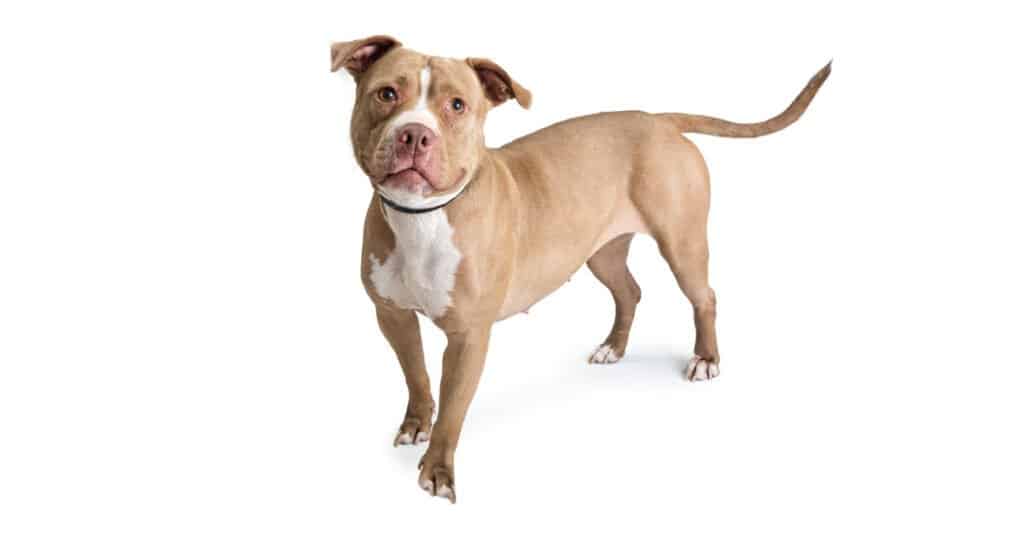
Pit bulls were once referred to as “nanny dogs” due to how gentle they were with children.
©Susan Schmitz/Shutterstock.com
The pit bull, or the American pit bull terrier, is a beloved dog breed. These pups have had to overcome quite a bit of stigma over the years. The breed was originally created to “bait” and bite bulls or other large animals. But they soon transitioned into farm dogs when baiting animals was outlawed in the 1800s.
During their work as farm dogs, many of these pups became treasured members of their farmer’s family. It was then noted just how gentle and loving the pit bull was with the children in the home. Eventually, they became “nanny dogs” that helped to guard children.
Due to the pit bull’s powerful stature, this breed has been used in a variety of cruel operations. These include illegal dog fighting rings around the globe. This has been a major contributor to the negative stigma surrounding the breed. However, those who own a pit bull will tell you just how far these rumors are from the truth. A pit bull should be raised in a loving environment that offers plenty of mental and physical stimulation each day. When this is the case, this canine friend can be a wonderful companion.
Pit Bull Growth and Weight Chart by Age
If you’re adopting a pit bull, you will need to have an idea of just how big they can get. Every pit bull will vary based on their genetics. However, we can offer you some averages on what to expect as they grow!
| Age | Male Weight | Female Weight |
|---|---|---|
| Birth | About 1 pound | About 1 pound |
| 1 Month | 3-5 pounds | 2-4 pounds |
| 6 Weeks | 5-10 pounds | 4-10 pounds |
| 2 Months | 5-15 pounds | 5-15 pounds |
| 3 Months | 10-20 pounds | 10-20 pounds |
| 4 Months | 15-25 pounds | 12-20 pounds |
| 5 Months | 15-30 pounds | 15-25 pounds |
| 6 Months | 20-35 pounds | 15-30 pounds |
| 7 Months | 20-40 pounds | 15-35 pounds |
| 8 Months | 25-45 pounds | 20-35 pounds |
| 9 Months | 25-50 pounds | 20-40 pounds |
| 10 Months | 30-55 pounds | 25-40 pounds |
| 11 Months | 30-55 pounds | 25-45 pounds |
| 12 Months | 30-55 pounds | 25-45 pounds |
| 2 Years | 30-60 pounds | 25-50 pounds |
As you can see, there is about a 30 pound weight range for both male and female pit bulls based on their age. Pit bulls can vary greatly in size based on their genetics, so the best indicator of eventual size is by looking at their parents.
When Will My Pit Bull Stop Growing?
Pit bulls are typically considered medium sized dogs, so this means they should reach their adult size by the time they reach 12 months of age. Some pit bulls will continue to fill out until they reach 18 months of age, but the majority of their growth will occur during that first year of life. By the time your pit bull is one, you should no longer expect any major growth spurts.
How Big Will My Pit Bull Be When It’s Fully Grown?
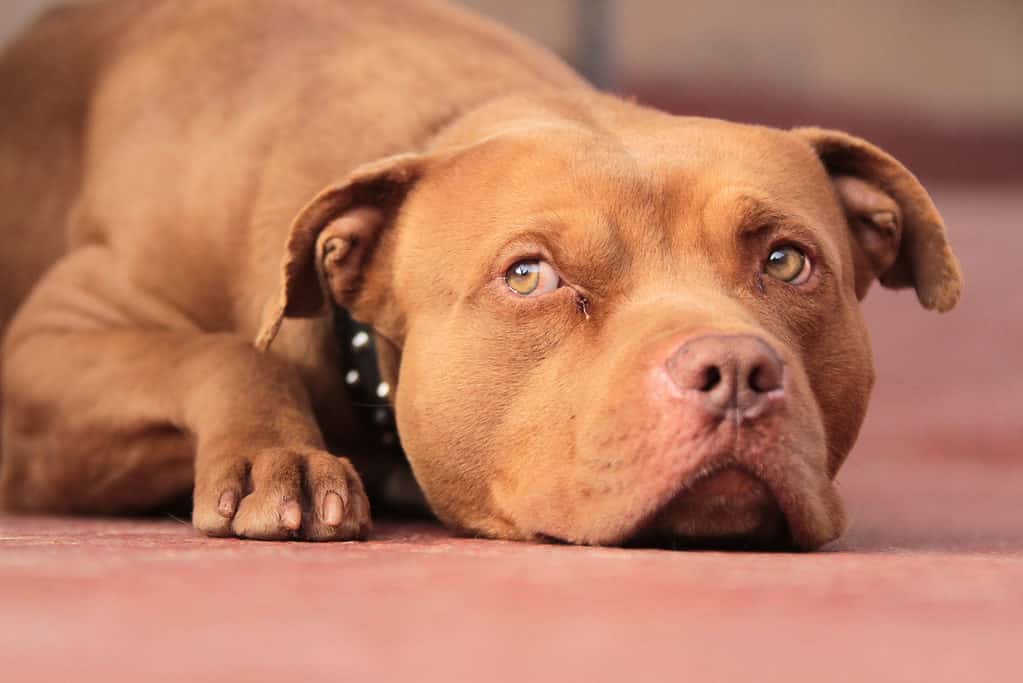
Most pit bulls will weigh anywhere from 30-50 pounds at adulthood.
©David Cohen 156/Shutterstock.com
As we discussed above, your beloved pit bull will likely finish most of their growing by the time they reach 12 months of age. There may be differences in eventual size when it comes to male or female pit bulls, but on average, you can expect your pit bull to weigh anywhere from 30-50 pounds.
Though this is the average to keep in mind for your growing pit bull pup, you should always remember that all dogs will vary in size based on their genetics. The best way to estimate your pit bull’s adult size is by meeting their parents.
When Should My Pit Bull Stop Eating Puppy Food?
Puppy food is one of the best tools to help your pit bull grown into a happy and healthy adult! Puppy food is fortified with essential ingredients that promote healthy growth, as well as additional calories per cup that accommodate their daily energy requirements.
Puppy food should always be offered to your growing pit bull until they reach maturity, so this means you should offer them a puppy diet until they reach 12 months of age. While some pit bulls will continue to fill out in the following months, they should have completed the majority of their growth by the one-year mark. Once they have reached 12 months of age, you can then transition them over to an adult kibble over a two-week period to prevent any GI upset from the switch.
When Will My Pit Bull Start Losing Teeth?
Once your pit bull puppy has entered the dreaded teething stage, you may wonder when they will finally start to lose their puppy teeth and develop their permanent teeth. Your pit bull puppy will begin to grow their baby teeth at around three weeks of age, and they should have a full set of puppy teeth by the time they reach six weeks. Your pup will sport these sharp baby teeth for about six weeks, and their adult teeth will soon erupt at around 12 weeks of age.
As your puppy begins to grow their permanent teeth, you will notice their baby teeth falling out as these adult teeth grow in. This will happen gradually over the next few months, but they should have a full mouth of permanent adult teeth by the time they are six months old. This means that they should not lose any teeth past the age of six to eight months.
When Should I Start Training My Pit Bull?
Though the pit bull is a kind and loving canine friend, they can begin to display undesirable behaviors is they are not properly trained. The pit bull is known for being hyperactive and a bit stubborn at times, so they will need a well-rounded training routine to help them become the best version of themselves.
No matter what age your pit bull is when you welcome them into your family, we suggest starting their training from that moment. Most dogs are receptive to learning basic commands from the time they are eight weeks old, meaning any time is the perfect time to jump into an obedience training routine! Starting their training from the moment they enter your home will lay the foundation for the well-rounded pup they will eventually become.
Just remember that while basic obedience training is essential for your beloved pit bull, you should always factor in socialization as well! An unsocialized pit bull may struggle around new people and animals, and this can be difficult to manage as they grow. An ideal socialization program for your pit bull puppy will involve introducing them to new dogs, new people, new settings, and even new sounds.
Socialization is critical for your pit bull’s development, but we do not suggest allowing your pit bull puppy to interact with unknown dogs until they are fully vaccinated for canine distemper and parvovirus. You can still take your pittie pup to public settings free of animal interaction once they have had their second round of puppy vaccines, but we suggest waiting until they have received all three puppy vaccines before they meet unknown canine friends.
What Commands Should I Teach My Pit Bull First?
If you are beginning your pit bull’s training journey, you may wonder which commands you should start with first. While you can certainly extend past these commands and dive into more advanced training, there are a few commands that we think all pit bull’s should be comfortable with.
The basic commands that we think all pit bull’s should know include:
- Sit
- Stay
- Come
- Lay down
- Drop it
In addition to the basic obedience commands we listed above, we want to remind you that you should also be socializing your pit bull pup throughout this training process as well. Be sure to introduce them to unfamiliar people (both inside and outside of your home), pets, settings, and sounds.
When Should My Pit Bull Be Housebroken?
Welcoming a puppy into your family is a wonderful time, but most cannot say the same for the potty training process. Potty training a puppy can be very frustrating, so many pet parents want to know when they should expect their puppy to be fully housebroken.
Though every pit bull will vary on how quickly they pick up on potty training, most pit bulls will be housebroken within 3-5 months of starting their potty-training process. Some puppies will catch on much sooner, but this appears to be the average for most medium to large breed dogs!
When Should My Pit Bull Be Spayed Or Neutered?
Unless you plan to breed your beloved pit bull, then sterilizing your canine fiend is often the best way to promote their health in the future. Spaying or neutering your pup will not only prevent any unwanted litters of puppies, but it will prevent any reproductive cancers down the line. Whether you have a male or female pit bull in your home, spaying and neutering is ideal for their future health!
Information may vary when it comes to the best time to sterilize your canine companion, but most vets will agree that the best time to spay or neuter is between six to 12 months of age. This seems to be the best time to not only decrease their risk of reproductive infections and cancer in the future, but it’s still a great window to prevent any undesirable behaviors that are driven by hormones.
When Will My Pit Bull Calm Down?
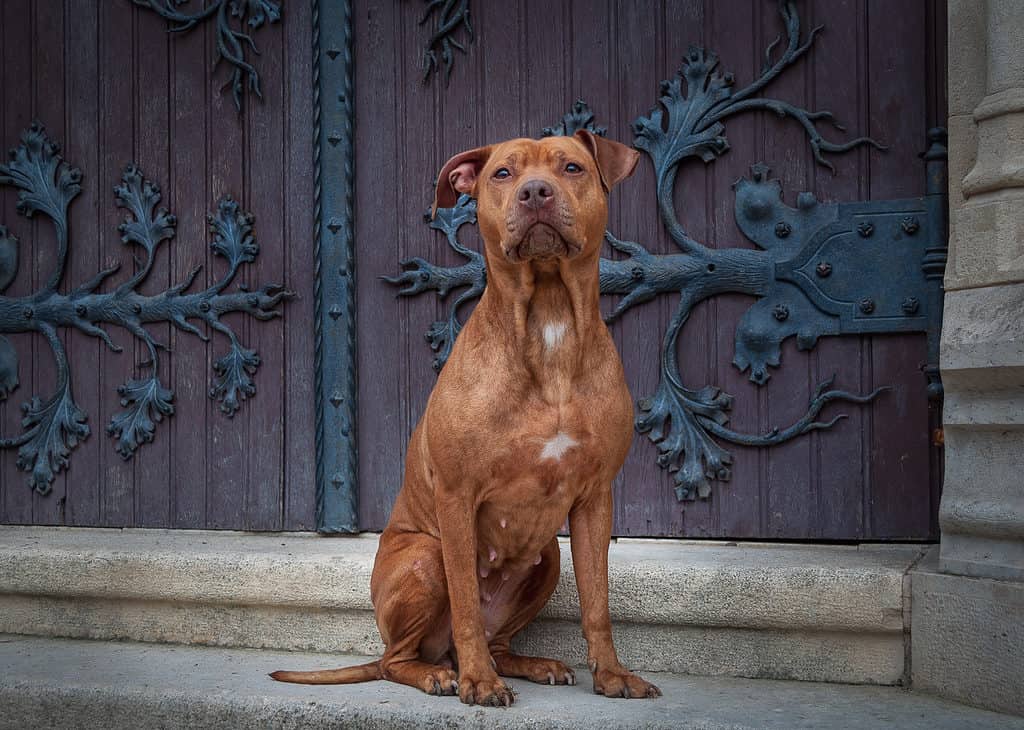
Pit bulls are known to have quite a bit of energy, especially during their puppyhood!
©Maya K. Photography/Shutterstock.com
Pit bulls are known to have quite a bit of energy, especially during their puppyhood! While the pit bull’s goofy and fun-loving nature are some of their best qualities, you may still wonder when they will begin to calm down a bit. Your pit bull may always enjoy playtime, but there is a time in which they will begin to calm down a bit and fall into adulthood.
Every pit bull will vary, but most pitties will begin to calm down once they have reached three to four years of age. They should still enjoy their favorite games and adventures at your side, but they should be much less hyper and more relaxed at this point.
Are Pit Bulls Dangerous to Own?
While we support the love and care of pet owners of all dog breeds, many question whether or not pit bulls are more aggressive than other dog breeds, and if so, are they safe to own? Sadly, pit bulls do have a bad reputation as aggressors. This goes back to their history as well as their physical attributes, ranging from strong jaws, a powerful bite force, and their tendency to hold and shake when biting. This dog breed does not socialize as well with other dog breeds, so much care and proper training should be taken so that your pit bull interacts with any other pets in the household with calmness and tolerance.
Statistically, pit bulls have been involved in a significant percentage of fatal dog attacks. For instance, according to The Animal Health Foundation, of the 46 total dog fatalities from dog attacks in 2019, 33 of them were killed by pit bulls. Because of these reports, some communities have passed legislation to discourage the ownership of pit bulls.
Common Health Issues Your Pit Bull Might Experience
Your pit bull will likely have a long and healthy life at your side, but there are a few health complications they are more prone to developing. All dog breeds will be predisposed to certain health conditions, and the lovable pit bull is no different. Let’s list a few of the health complications that pit bull parents should be on the lookout for!
Skin allergies: pit bulls are highly prone to developing allergies, but especially skin allergies. Pit bulls can be allergic to anything in the world around them, ranging from plant pollen to certain fragrances. Some of the most common signs of allergies in pit bulls include red skin, itching, sores on the skin, excessive shedding, skin odor, ear infections, and paw chewing.
Ear infections: Due to the increased risk of skin allergies in pit bulls, they are more prone to developing painful ear infections. Some of the most common signs of an ear infection in pit bulls includes head shaking, pawing at the ears, red ears, ear odor, crusty ears, and facial sensitivity.
Joint Disease: Pit bulls have an increased risk of developing painful forms of joint disease. This can include complications like hip dysplasia and elbow dysplasia, and eventually arthritis as a result of the joint deterioration. Some of the most common signs of joint disease in pit bulls include joint stiffness, limping, hesitance with physical activity, difficulty getting up and down, muscle wasting in the hind end, joint swelling, and a change in gait.
Thyroid disease: Pit bulls have a higher risk of developing a thyroid disease known as hypothyroidism. This is when the thyroid does not function the way it should, leading to a reduction in the dog’s metabolic capabilities. Some of the most common symptoms of hypothyroidism is weight gain, hair loss. dry skin, lethargy, and skin infections.
Cardiac disease: Pit bulls have a higher risk of developing heart disease due to cardiac abnormalities among the breed. The most common symptoms of cardiac disease in pit bulls include frequent coughing, exercise intolerance, labored breathing, weakness, and abdominal distension.
The Biggest Pit Bull Ever Recorded
Most pit bulls will not exceed 60 pounds, but a pit bull named Hulk is setting his own standard! This impressive canine friend weighs a whopping 170 pounds, and he has made quite the name for himself in the social media world! He is now so popular that his litters are worth up to $500,000!
Though Hulk may look intimidating, he is said to be a loving and gentle companion to his family. Not only is he a wonderful addition to his family, but he even tends to his puppies with care. There is no dog out there quite like Hulk!
Photos Of Pit Bulls as Puppies
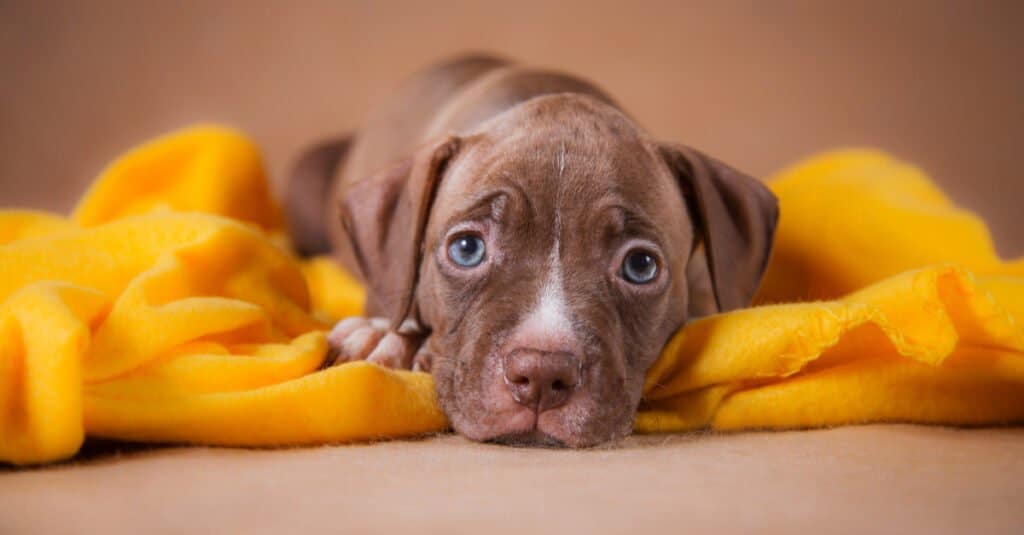
This adorable pit bull puppy has striking eyes.
©dezy/Shutterstock.com
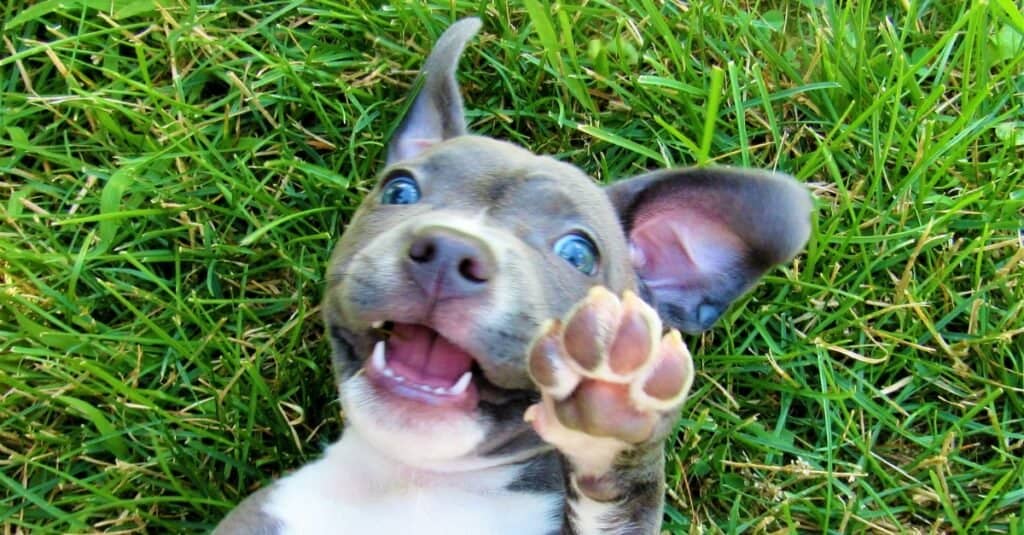
Pit bull puppies can be quite playful, like this little guy rolling in the grass.
©iStock.com/AimesElement
Photos Of Pit Bulls Around 6 Months
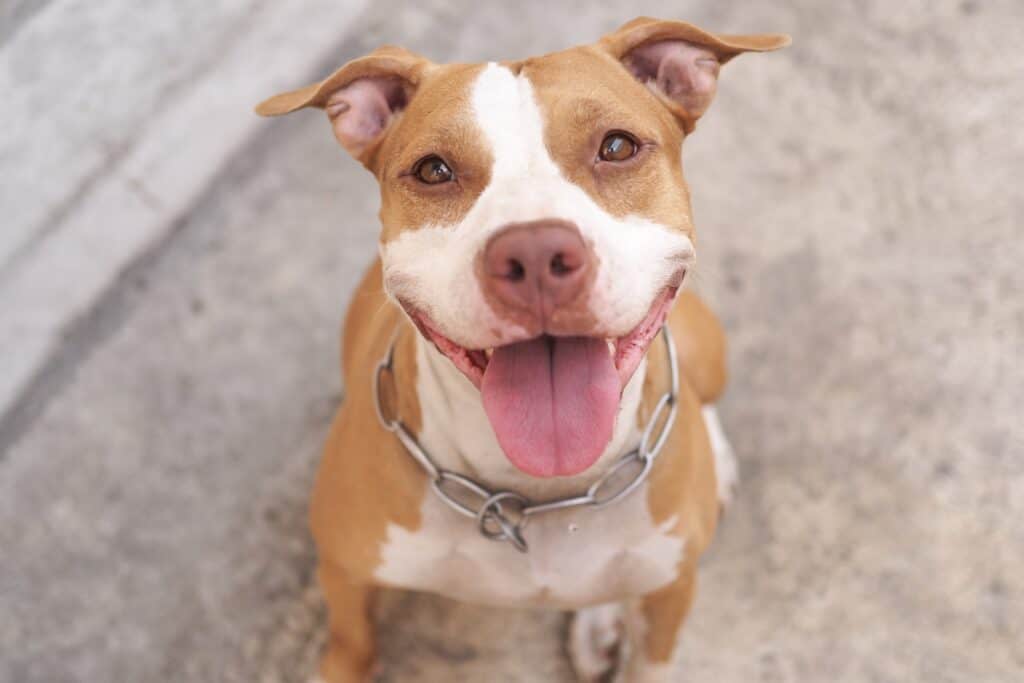
At around six months, a young pit bull will have grown significantly.
©Natthapot Chantaraviboon/Shutterstock.com
Photos Of Pit Bulls as Adults

A well-treated and trained pit bull makes a happy, wonderful companion.
©Diego Thomazini/Shutterstock.com

Sometimes pit bulls look like they’re smiling!
©Mary Swift/Shutterstock.com
Do you think a pit bull is right for your family?
The photo featured at the top of this post is © Natthapot Chantaraviboon/Shutterstock.com
Ready to discover the top 10 cutest dog breeds in the entire world?
How about the fastest dogs, the largest dogs and those that are -- quite frankly -- just the kindest dogs on the planet? Each day, AZ Animals sends out lists just like this to our thousands of email subscribers. And the best part? It's FREE. Join today by entering your email below.
Thank you for reading! Have some feedback for us? Contact the AZ Animals editorial team.







